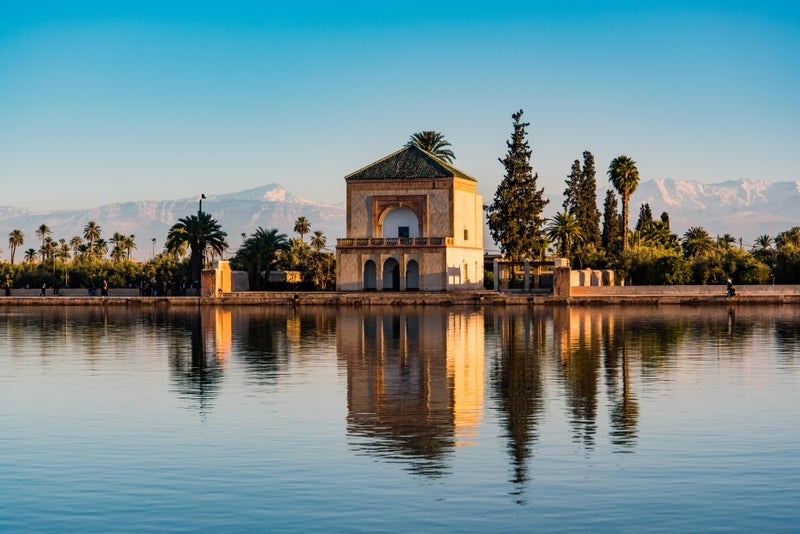An insider guide to 48 hours in the Red City, where Europe, Africa and the Middle East mingle and merge. Copy link. twitter. facebook. whatsapp. Founded almost a thousand years ago, Marrakech has always been one of the great cities of the Maghreb. Somehow this bursting-at-the-seams medina exists on the edge of the Sahara Desert, its pink pise (rammed earth) palaces framed by the snow-capped High Atlas. In its busy souks, Europe, Africa and the Middle East mingle and merge, and the past and present are hard to tell apart.
But make no mistake, Marrakech isn’t some petrified piece of history. Instead, this centuries-old trading hub is a creative sweet spot where ideas thrive and a buzz of entrepreneurialism and salesmanship charges the air with an intoxicating, and sometimes, intimidating energy. This isn’t a place you can gracefully glide through. Instead, you’ll find yourself telling jokes with snake charmers, hankering after the latest henna tattoo or getting a scrub down in the local hammam. Pause for unexpected banter and beauty as shafts of light filter through the sun shades striking the ruby red pomegranates on the nearest juice stall, after all, what are the chances you’ll come this way again?.
Scroll down to find plenty to inspire you for a short break in the city, and for more inspiration, see are our guides to Marrakech's best restaurants, attractions, shopping, bars and hotels. Start by discovering the city’s history at the 16th-century Saadian Tombs, where Sultan al-Mansour spared no expense decorating his mausoleum with imported Italian Carrara marble and a gilded honeycomb muqarnas ceiling that still dazzles those who look upon it. The entrance to the tombs is opposite the Kasbah Café. Note you should arrive when it opens to see it at its most peaceful.
Move on to al-Mansour’s once magnificent Badi Palace (Ksibat Nhass), now a monumental ruin with vast reflecting pools and impressive views of the city from its ramparts. Also displayed here is the Koutoubia’s original 12th-century minbar (prayer pulpit) made of carved cedarwood and originally decorated with silver inlay and ebony. From here it’s a short hop to the beautiful Bahia Palace (Avenue Imam El Ghazali), a vast, gorgeously decorated palace once owned by slave-turned-vizier Abu ‘Bou’ Ahmed.
If you’re a return visitor and have seen the main sights, consider an electric bike tour with Samir at Chic Biking or one of Emilia Thalheim’s street art tours at Marrakech Art Tour. Each of them will guide you around the medina’s hidden corners and neighbourhoods discovering things you won’t have seen before. Wander up Riad Zitoun el Jdid browsing the boutiques as you go until you arrive at the Mandala Society, which serves a vegetarian menu, or Lebanese Naranj, a few steps further north. Then, head northwest across the Djemaa el-Fna and pick up Rue Mouassine, which is lined with some of the souk's chicest shops. Just past the Mouassine fountain, you can slip into Le Jardin Secret, one of the Medina’s largest and most important gardens set out in the shell of a 19th-century palace. Divided into two distinct areas, the gardens are a perfect example of Islamic landscaping.
The first area faithfully recreates a Persian 'paradise' garden, featuring traditional fruit trees such as olive, pomegranate, fig and date, which all have symbolic meaning and health benefits; while the second, smaller garden nurtures exotic plants in a fourfold layout. Just as interesting is the elaborate irrigation system that weaves through the gardens, part of an ancient network that once distributed water from artesian wells (fed by the ring of mountains around Marrakech) throughout the city.
Dining in the Medina is an adventure wherever you choose to eat. Like a magnet, everyone is drawn to the Djemaa el-Fna where smoke rises from hundreds of barbecues and storytellers, Gnawa musicians, acrobats and fortune-tellers attract throngs of Marrakshi’s out for their evening constitutional. You can eat here on long trestle tables, but regardless you should come for the show. Carry a handful of coins so you can tip the performers (a few dirhams is appropriate). If you do decide to eat in the square, stick to your own bottled water and use your bread instead of rinsed utensils.
If you do decide to eat in the square, preview your meal with a drink on the roof terrace of Café de France from where you’ll have a birds-eye view of the action. (Remember to stick to your own bottled water and use your bread instead of rinsed utensils.) Or, if you’d like some local guidance consider a tour with Amanda Mouttaki who runs Moroccan Food Adventures. Afterwards, you can head to Pâtisserie des Princes for ice cream and sweet treats. For a more elevated dining experience or a dance after dinner, head to hybrid DaDa tucked in a corner of the Djemaa, where you’ll find multiple restaurants and an underground club in a reimagined bus station.
When fashion icon Yves Saint Laurent first arrived in Marrakech in 1964 he was overwhelmed by the city’s vivacity. The experience changed the way he saw the world and he ditched his previously rigorous monochromatic look in favour of an outrageously bold palette of Fauvist colours. It comes as no surprise then that Jardin Majorelle, the home where he lived with his partner Pierre Bergé, is painted an intense shade of ultramarine blue. Book tickets online and arrive early to enjoy the extraordinary desert garden filled with giant cacti, palms and bamboo.






























